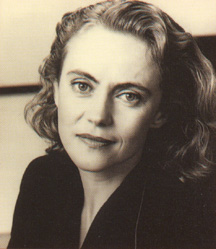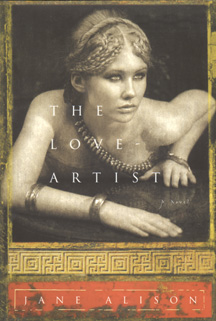|
Web
Exclusives:Features July
17, 2001: By Andrea Gollin '88
Sure, there have been
other novels (two, unpublished to date), other preoccupations. She's
held a variety of jobs ranging from editor to fundraiser to teacher
and lived in many places (including, currently, Germany) but her
interest in Ovid persisted. So, having become a fiction writer,
she did what many an author's done before, and turned fixation into
fodder.
Alison has taken these
circumstances and created a dense and lyrical novel that accounts
for all three circumstances. Her story revolves around corrupted
love, destructive creativity and a ravenous thirst for immortality.
It begins when Ovid, unsettled by the cold shoulder he's receiving
from Augustus and in search of inspiration, decides to leave Rome
for a time and return after the publication of Metamorphoses, a
work he hopes will salvage his reputation with the emperor. He journeys
east to the Black Sea, where he meets Xenia, a young, mysterious
woman with mystical powers: "she could hear and see the tiny particles
that flew from people ÿ their thoughts, dreams, curses, and
glimpses of their futures." Xenia is enraptured with
Ovid from his poems alone; Ovid quickly becomes obsessed with Xenia.
In short order they return to Rome and Ovid sets about writing Medea.
Xenia unwittingly serves as a sort of test laboratory; from Ovid's
point of view she's not there merely to be his lover or even his
muse, but to have the tragedy enacted upon her so he can observe
and record her reactions. Ovid also acquires a patron, Augustus's
granddaughter Julia, who detests the emperor and is waging battle
against him in the only way she can. The characters are all
plotting, all secretive, and all have a single-mindedness of purpose
that pushes aside any consideration for others. As the novel progresses
Alison ratchets up the suspense and sense of impending horror while
doing a masterful job of keeping each of the characters' machinations
secret not only from each other but from the readers. As it plays
out, Augustus seems entirely justified for banishing Ovid and Julia
— in fact, exile seems lenient. Ovid is especially monstrous,
which makes it even more interesting that Alison views him as her
greatest influence as a writer, and says that, despite how she portrayed
him in the book, "I adore him as both a persona and a writer." Although the idea for
the novel was years in the making, the actual writing of it took
about two years. There was plenty of research as well, the highlight
of which was imagining Ovid's home. To describe Ovid's house, Alison
first had to envision it. To do so, she traveled to Rome with her
architect husband. They spent a lot of time picking out the site
of his home, then studied ruins to create the house itself. As for
the furniture, they visited museums and engaged in what Alison calls
"a silly, vicarious shopping trip." Her book's been getting
the kind of attention every writer dreams of: She's garnered favorable
reviews in several major publications, including two reviews in
the New York Times. As an added bonus, Sex and the City has requested
permission to use The Love-Artist as a prop; what more could anyone
aspire to? "I was worried that people would see Rome and Ovid and
curl up," Alison notes. "I'm out-of-my-mind thrilled with the reception."
She hypothesizes that some of the same forces that inspired her
to write the book may play into the interest it's receiving: "I
was tired of writing realistic, contemporary prose," she says. "Maybe
this appeals to people because it's different ÿ a different
time, a different world. I can only guess." As for what comes next, Alison is at work on a new novel, this one set in modern-day New Orleans. For now, she's leaving Ovid behind, although one wonders whether she'll come back to him again, as she notes "he's in my head and in my blood." Andrea Gollin is a freelance
writer living in Miami. She can be reached at agollin@ix.netcom.com
|

 It's
been 20 years since Jane Shumate Alison '83 first started thinking
about the Roman poet Ovid — as a sophomore studying classics
at Princeton she "became fixated on Ovid in exile," she says. Now,
with the release of her first published novel, The Love-Artist,
Alison has returned to her youthful fixation, although it's probably
more accurate to say she never fully left it.
It's
been 20 years since Jane Shumate Alison '83 first started thinking
about the Roman poet Ovid — as a sophomore studying classics
at Princeton she "became fixated on Ovid in exile," she says. Now,
with the release of her first published novel, The Love-Artist,
Alison has returned to her youthful fixation, although it's probably
more accurate to say she never fully left it.  The
Love-Artist is set just prior to Ovid's banishment from Rome to
Tomis (a desolate backwater on the Black Sea) in A.D. 8. Very little
is known about why Ovid was exiled by Emperor Augustus, although
the "immorality" of his Art of Love is often cited as a possible
explanation. That's mystery number one. The second mystery is the
missing Medea, Ovid's tragic play that was renowned in his time
but is now lost, save for two lines. A third mystery is that Augustus's
granddaughter, Julia, was exiled at the same time, also without
explanation.
The
Love-Artist is set just prior to Ovid's banishment from Rome to
Tomis (a desolate backwater on the Black Sea) in A.D. 8. Very little
is known about why Ovid was exiled by Emperor Augustus, although
the "immorality" of his Art of Love is often cited as a possible
explanation. That's mystery number one. The second mystery is the
missing Medea, Ovid's tragic play that was renowned in his time
but is now lost, save for two lines. A third mystery is that Augustus's
granddaughter, Julia, was exiled at the same time, also without
explanation.